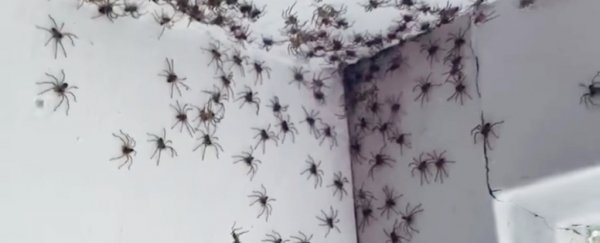The pitter-patter of little feet in a child's bedroom is a joyous sound – except perhaps when those feet belong to hundreds of baby huntsman spiders.
"Gaaaahhhhhhhh, a friend of mine in Sydney just walked into her daughter's room and found this," Hobart, Australia resident Peta Rogers tweeted on Jan. 27.
Rogers' Sydney friend, who asked not to be identified on social media, had sent Rogers photos and a video of her daughter's bedroom, after the teen told her "Mom, we've got a bunch of spiders up there," the Australian Broadcasting Company (ABC) reported on Jan. 30.
So, for everyone saying it's Photoshopped, here is her actual video. pic.twitter.com/2Zcro0nra7
— 💧 Petie R 🇦🇺🌘🌗🌕🌓🌒🌱🌈🌏 (@PrinPeta) January 28, 2021
When Rogers' friend went to investigate, she found quite a few spiders in the corner of the room.
"That's not too bad, there's maybe 50 or 60," she says in the video. And then she turned the camera toward another corner, revealing at least twice as many spiderlings crouching on the walls and ceiling.
"They're so cute!" she exclaims.
Related: In photos: The amazing arachnids of the world
As the Sydney woman filmed her leggy houseguests, she speculated that they were baby huntsman spiders, which are in the spider family Sparassidae and are widespread in Australia and in other places with warm climates.
One huntsman species, the giant huntsman spider (Heteropoda maxima) from Laos, has a leg span of up to 12 inches (30 centimeters), and is the biggest spider in the world by diameter. But the average huntsman has a leg span of no more than 5 inches (12.7 cm), and a body length of just 1 inch (2.5 cm) long.
During summer in Australia, huntsman populations boom, and it's not unusual for the spiders to find their way into people's homes, Australia's Nine News reported on Monday (Feb. 1).
In fact, many Sydney residents had reported huntsman infestations that week, likely because of recent weather, according to ABC.
A low pressure front after several days of high temperatures brought rain and humidity; huntsman spiders often seek shelter in human homes when heat and moisture are too intense, because houses provide lots of safe nooks and crannies where the spiders can hide – and where females can lay their eggs, said arachnologist Robert Raven, head of Terrestrial Biodiversity at Australia's Queensland Museum.
However, this type of weather also ushers in favorable conditions for huntsman eggs to hatch, Raven added.
"Low pressure is one of the triggers for emergence from the egg sac," Raven told ABC.
Warm, moist air is ideal for thin-skinned baby spiders, which quickly dehydrate when conditions are too dry, and one egg sac can contain hundreds of baby huntsmen – which could lead to mass infestations such as the one in the video.
Alas, these dense clusters of cute baby spiders don't linger for long, as the spiderlings are "highly cannibalistic" and quickly begin devouring each other within a day or two, arachnologist Lizzy Lowe, a postdoc in the Behavioural Ecology Group at Australia's Macquarie University, told Nine News.
Related content:
Weird and wonderful: 9 bizarre spiders
In photos: Fish-eating spiders around the world
Creepy, crawly & incredible: Photos of spiders
This article was originally published by Live Science. Read the original article here.
